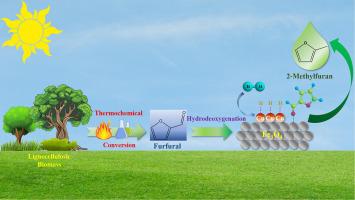当前位置:
X-MOL 学术
›
J. Ind. Eng. Chem.
›
论文详情
Our official English website, www.x-mol.net, welcomes your feedback! (Note: you will need to create a separate account there.)
Selective furfural hydrodeoxygenation over Cu-Fe catalysts with In-Situ Cu@Fe3O4 formation
Journal of Industrial and Engineering Chemistry ( IF 6.1 ) Pub Date : 2024-04-14 , DOI: 10.1016/j.jiec.2024.04.011 Anurag Jaswal , Vijay Garule , Akansha Pandey , Piyush Pratap Singh , Tarak Mondal , Prakash Biswas
Journal of Industrial and Engineering Chemistry ( IF 6.1 ) Pub Date : 2024-04-14 , DOI: 10.1016/j.jiec.2024.04.011 Anurag Jaswal , Vijay Garule , Akansha Pandey , Piyush Pratap Singh , Tarak Mondal , Prakash Biswas

|
This study investigates Cu-Fe mixed oxide catalysts with varying Cu/Fe molar ratios (0.5 to 2) synthesized via a sol–gel method for vapor-phase FFR HDO. The catalysts were characterized using XRD, H-TPR, NH-TPD, N physisorption, FESEM and XPS to gain sights into their properties. The characterizations unveiled the critical role of Cu/Fe molar ratio in influencing the properties and performance of the catalysts in FFR HDO. Fe promoted the dispersion of CuO, especially at a Cu/Fe ratio of 1, revealing synergistic Cu-Fe interactions. Increasing Cu/Fe ratio enhanced the reducibility of Fe but diminished that of Cu. Extensive investigations were conducted to assess the impact of key parameters, including Cu/Fe ratio, temperature, contact time, reduction temperature and H/FFR molar ratio. The Cu-Fe mixed oxide catalyst with Cu/Fe = 1 proved to the optimal catalyst, exhibiting > 99 % FFR conversion and 90 % 2-MeF selectivity at H/FFR = 15, 230 °C, and 0.5 g h g. The extended evaluation of catalytic activity demonstrated sustained high performance, with stable conversion and 2-MeF selectivity values of > 99 % and 90 % over a period of 12 h. Even after 24 h on stream, the conversion remained above 90 %. Subsequent regeneration study showed partial recovery of the activity, with the catalyst maintaining conversion and selectivity consistently at about 85 % and 86 %, respectively for 10 h. Catalyst deactivation was a result of the site and/or pore blockage caused by the adsorption of FFR and FAL as well as the formation of oligomeric compounds on the catalyst’s surface.
中文翻译:

Cu-Fe 催化剂上的选择性糠醛加氢脱氧并原位形成 Cu@Fe3O4
本研究研究了通过溶胶-凝胶法合成的气相 FFR HDO 具有不同 Cu/Fe 摩尔比(0.5 至 2)的 Cu-Fe 混合氧化物催化剂。使用 XRD、H-TPR、NH-TPD、N 物理吸附、FESEM 和 XPS 对催化剂进行表征,以了解其性能。这些表征揭示了 Cu/Fe 摩尔比在影响 FFR HDO 催化剂的性质和性能方面的关键作用。 Fe 促进了 CuO 的分散,特别是在 Cu/Fe 比率为 1 时,揭示了 Cu-Fe 的协同相互作用。增加 Cu/Fe 比例可提高 Fe 的还原性,但会降低 Cu 的还原性。我们进行了广泛的研究来评估关键参数的影响,包括铜/铁比、温度、接触时间、还原温度和 H/FFR 摩尔比。 Cu/Fe = 1 的 Cu-Fe 混合氧化物催化剂被证明是最佳催化剂,在 H/FFR = 15、230 °C 和 0.5 gh g 时表现出 > 99% 的 FFR 转化率和 90% 的 2-MeF 选择性。催化活性的扩展评估证明了其持续的高性能,在 12 小时内具有稳定的转化率和 2-MeF 选择性值 > 99 % 和 90 %。即使投产24小时后,转化率仍保持在90%以上。随后的再生研究显示活性部分恢复,催化剂的转化率和选择性分别持续保持在约 85% 和 86%,持续 10 小时。催化剂失活是由于 FFR 和 FAL 的吸附以及催化剂表面低聚化合物的形成导致位点和/或孔堵塞的结果。
更新日期:2024-04-14
中文翻译:

Cu-Fe 催化剂上的选择性糠醛加氢脱氧并原位形成 Cu@Fe3O4
本研究研究了通过溶胶-凝胶法合成的气相 FFR HDO 具有不同 Cu/Fe 摩尔比(0.5 至 2)的 Cu-Fe 混合氧化物催化剂。使用 XRD、H-TPR、NH-TPD、N 物理吸附、FESEM 和 XPS 对催化剂进行表征,以了解其性能。这些表征揭示了 Cu/Fe 摩尔比在影响 FFR HDO 催化剂的性质和性能方面的关键作用。 Fe 促进了 CuO 的分散,特别是在 Cu/Fe 比率为 1 时,揭示了 Cu-Fe 的协同相互作用。增加 Cu/Fe 比例可提高 Fe 的还原性,但会降低 Cu 的还原性。我们进行了广泛的研究来评估关键参数的影响,包括铜/铁比、温度、接触时间、还原温度和 H/FFR 摩尔比。 Cu/Fe = 1 的 Cu-Fe 混合氧化物催化剂被证明是最佳催化剂,在 H/FFR = 15、230 °C 和 0.5 gh g 时表现出 > 99% 的 FFR 转化率和 90% 的 2-MeF 选择性。催化活性的扩展评估证明了其持续的高性能,在 12 小时内具有稳定的转化率和 2-MeF 选择性值 > 99 % 和 90 %。即使投产24小时后,转化率仍保持在90%以上。随后的再生研究显示活性部分恢复,催化剂的转化率和选择性分别持续保持在约 85% 和 86%,持续 10 小时。催化剂失活是由于 FFR 和 FAL 的吸附以及催化剂表面低聚化合物的形成导致位点和/或孔堵塞的结果。



























 京公网安备 11010802027423号
京公网安备 11010802027423号